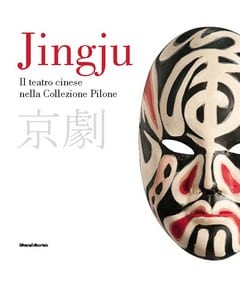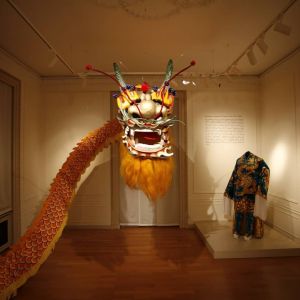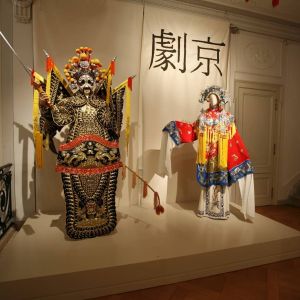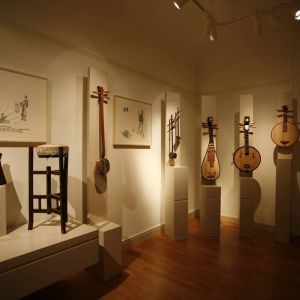HELENEUM LUGANO
The temporary exhibition, set up on the first floor of the Heleneum, presents a selection of artworks and objects of traditional Chinese theatre from the Peking Opera, in Chinese Jingju, or “Capital Drama”. The source of origin of the precious artefacts is the Pilone Collection, one of the most important of its kind in the world, assembled in the second half of the 20th century by the sinologist Rosanna Pilone and donated in 2013 to MUSEC by the “Ada Ceschin and Rosanna Pilone” Foundation in Zurich.
The collector Rosanna Pilone
Venetian by birth, Rosanna Pilone (1931-2006) has always lived in Milan. A journalist by profession, she developed an interest, soon turned into a passion, for China from a very young age. Over time, she became a profound and esteemed expert on its culture and theatre. She has translated several works by Confucius and Laozi for Rizzoli and has written and edited a number of important studies. In 2001, Rosanna Pilone created the Ada Ceschin Foundation with the aim of promoting cultural activities, in particular research, study, knowledge and dissemination of oriental cultures in Switzerland and other European countries. After Rosanna Pilone’s death, the Foundation decided to donate the entire Collection to MUSEC so that it could be scientifically catalogued, adequately studied, made available to scientific research, in particular to young scholars, and finally valued and made known to the public.

Beijing Opera
The history of the theatrical experiences that developed over the centuries in China is shown with particular effectiveness and charm in the Beijing Opera, which is the result of the overlapping of different local historical traditions scattered over the immense Chinese territory. Beijing Opera is characterised by an admirable amalgamation of music, singing, acting, literature and martial arts. Chinese theatre has its roots in the ritual dances practised in dynastic courts centuries before the birth of Christ. But it was from the time of the Tang dynasty (618-907) that the first academies for the study and practice of theatre emerged, thanks to imperial support. Unesco recognised the Kunqu Theatre, the original matrix of Jingju, as an intangible cultural heritage of mankind in the early 2000s. Composed of more than 350 works, the Collection has been the subject of a long and painstaking study conducted since 2009 by the MUSEC team, assisted by numerous international specialists, with the aim of enhancing and presenting to the public the richness of its materials. On display are painted masks and faces, costumes and make-up accessories, headgear, fans, footwear, weapons, musical instruments, props and set models. The exhibition, curated by Barbara Gianinazzi and Marco Musillo, proposes an exhibition itinerary organised in different sections that deal with the following thematic nuclei: the architecture of the theatre building and music; the actor’s body; costumes and accessories; set design and evocative elements; Mei Lanfang and the reform of the Opera house.
Chinese Theatre
Evoking rather than reproducing: this is the concept on which Chinese theatre is based. Starting with the set design that creates an ‘other’ reality mainly through symbolic elements, rather than through the construction of real Western-style sets. For example, if an actor appears on stage holding an oar, it means he is on a boat. The acting itself is based on the concept of evocation: raising a foot as if starting to walk physically communicates to the audience that the protagonist is starting a long journey on foot. The way in which the actors move their bodies, make up their faces, and dress is fundamental in this respect. Costumes in particular play a central role in Chinese theatre, because it is only through them that the audience can identify the characters and their characters. The typical roles in Jingju, and thus the different genres of costumes, are grouped into four main categories: female (dan), male (sheng), painted face (jing) and comedian or comic (chou).
The ‘Ada Ceschin and Rosanna Pilone’ Foundation
The ‘Ada Ceschin and Rosanna Pilone’ Foundation has a close relationship with MUSEC. Indeed, for years it has supported its activities, in particular by awarding scholarships to young researchers active in the study of the arts and civilisations of the East. In addition to the important donation of the Pilone Collection, in 2012 the Foundation deposited a prestigious collection of over 10,000 hand-painted Japanese albumen photographs and postcards, dating back to the late 19th and early 20th century, which constitute one of the focal points of the Museum’s scientific research programme. As part of the project to enhance the Pilone Collection, the Museum has also been able to take advantage of the valuable collaboration of the Chinese Cultural Centre the Bridge at Lugano, the Martino Martini Study Centre at Trento and the Museum der Kulturen at Basel.





